Table of Contents
When the great English novelist George Eliot wrote back in the 19th century, “It is never too late to be who you might have been,” she didn’t have in mind email marketing. Yet, she manages to encompass the importance of optimization in this inspirational quote that perfectly fits any business-related growth context. In terms of email marketing, we can confidently say that G. Eliot nailed it!
Although email marketing dates back to 1978, when the first email marketing blast was sent, it still remains the most popular communication channel up to date and keeps growing in popularity.
Numbers speak for themselves:
Table of contents
- 1What is Email Marketing?
- 2How Can Email Marketing Fuel Your Overall Inbound Strategy
- 3How To Build An Email List For Your Online School?
- 4Email Marketing Campaigns: Where to Start?
- 5Email Marketing Metrics: How to Evaluate and Use Them Effectively
- 6Increase Your Course Sales/Conversions (With CTAs)
- 7Email Writing: How to Write Better Email Content
- 8Ready to Invest in Email Marketing?
But first things first, let’s see what email marketing is, what it comes with and how it can help you increase your course sales and grow your business.
What is Email Marketing?
Email marketing is a digital marketing strategy that allows business owners to build a strong communication channel with their audience, existing and potential customers. The term ‘email marketing’ refers to all the initiatives a business takes to communicate and build a relationship with its audience through promotional messages sent by email.
Email marketing aims to inform, educate, build customer loyalty, trust, brand awareness, gain and nurture new leads with the potential to become recurring customers.
How Can Email Marketing Fuel Your Overall Inbound Strategy
Through email marketing, a business gets access to a prospect’s inbox and establishes a relationship with them. The number of emails, the frequency, and the type of content a business sends out directly influences these prospects, who get to decide whether they want to buy from a company.
Most emails that businesses send have the following topics:
Prospects choose to receive such emails from companies with something to offer – a product or a service that can help them solve a specific problem they are experiencing or improve their quality of life. This means that if they are not interested in your product or your company, they will most likely opt out or unsubscribe from your email list altogether.
A successful email marketing campaign starts by identifying your target audience, their needs, sending them well-designed emails relevant to them, and prompting them to take action.
The Email Marketing Lifecycle
A customer’s path to buying a product is explained in detail through the lifecycle of email marketing. When you understand this process and know where your customers stand, you can use personalized email content that effectively addresses their needs.
The way you map customer’s journey would help a lot with stepping up your customer experience game. The journey can becomes clearer when using the AIDA process – a method that identifies the steps to a customer’s purchase decision. AIDA consists of the following steps:
How To Build An Email List For Your Online School?
With no email list, you have no subscribers and no audience to advertise your products. You can’t start an email marketing campaign without one.
If you want to sell your online course, you get to launch it through email and let your subscribers – aka your most loyal followers – be the first to know about it.
Email List Building: 3 Steps To Success
As a prerequisite to building your email list, you will need the following:
*LearnWorlds comes with a blog and opt-in forms and connects with the top email marketing platforms to grow your email list and sell online courses, all in one place!
STEP 1: Gather Your Contacts
Having no email list doesn’t mean that you have to build it from scratch.
Save time by starting early and using your existing customers’ contacts that are already in your database or CRM system. Don’t forget to gather email addresses from previous campaigns or any business cards you have collected.
If you don’t have any contacts in your inventory, start asking your friends, family, and existing social media followers to join your email list and even share it with their networks. Try Twitter, Instagram, Facebook, and LinkedIn to see if your contacts share their email addresses publicly.
For GDPR reasons, remember to write a proper post or send a personal message asking them to join your email list on their own accord. Adding without permission is a big no-no, so take the time to follow up with everyone to make sure it’s OK to add them to your email list.
While you are at it, be conscious of who you are adding to your list.

First, explore who fits your buyer’s persona best and find out what their needs are. A buyer persona should help you create a network of people who represent your ideal customer.
While often overlooked, this step is crucial because it gives you valuable information about your audience’s demographics and helps you create the content that resonates best with them.
Once you have a few hundreds of relevant contacts, use a cold email and invite all those recipients to join your email list.
STEP 2: Create Engaging Content
After getting your first contacts, you need to focus on your marketing copy and email content.
To attract people, you need to have a website with engaging content. Your online school’s website is where people can come and check out your courses. If you don’t have one, you may be losing many potential leads.
With LearnWorlds’ site builder, you can build your own website in just a few minutes, choosing from a pool of ready-made templates and designs that are best-tailored for course creators.
From there, you can create all sorts of pages, including landing pages, product pages, About Us pages, Thank You pages, a blog, and customize your page design as much as you like. You can also experiment with typography, colors, CTA buttons and create your own pop-ups to collect emails.
Need help with your landing page? Find out how you can build yours here.
Now, in terms of email content, ensure that the content meets the following criteria before sending your emails:
Creativity: The design of the email (the layout, use of color and image, and the copy). The form and location of the calls-to-action are also critical.
Relevance: Do the offer and creativity of the email meet the needs of recipients?
Incentive/Offer: What’s in it for your subscribers? What benefit does the recipient gain from clicking on the hyperlink(s) in the email?
Targeting/Timing: Is a single message sent to all customers on the list or to the different segments on our list? Timing refers to when the email is received – the time of day, the day of the week, the point in the month, and even the year – does it relate to any particular event?
Integration: Are email campaigns part of your integrated marketing communications? Are they creative and copy consistent with your brand? Does the message reinforce other connections?
These are the best principles for a successful email campaign, as described in Dave Chaffey’s book “Total email marketing: maximizing your results from integrated e-marketing” (2006).
The quality of your email content is more important than quantity when it comes to email list building. So, the more valuable your content is and the more relevant to your audience’s needs, the better it will perform and generate the leads you want.
For more tips on creating excellent email content, jump to Email Writing
STEP 3: Streamline Your Emails
With the help of an email service provider, you can drip-feed your email content and have it delivered to your subscribers’ inbox in the order you want them to receive it.
Drip campaigns are also called “automated email campaigns,” “lifecycle emails,” “autoresponders,” or “marketing automation.” They are designed to send pre-written messages known as ‘drips’ to your subscribers over a certain period.
Drip email sequences can build a stronger rapport with your audience. By putting subscribers into different funnels, you can:
You can learn more about how to drip feed your campaign here.
Grow Your Email List: 3 Steps
As your business grows, you will need to expand your email list. Always be on the lookout for new subscribers to add to your email marketing campaigns and increase your course sales.
To do this, you need to experiment with some other marketing tactics.
STEP 1: Use Lead Magnets
You can offer a lead magnet instead of simply asking your site visitors to join your email list or subscribe to your newsletter.
A lead magnet is an item or service that you give out for free and aims to gather contact emails that can help you grow your email list.
Here are some excellent lead magnet ideas:
When you give people freebies in exchange for their email addresses, they are more likely to sign up to your list. Chances are even higher if the lead magnet you choose provides real value to them and high-quality content (e.g., a free ebook).
A good lead magnet should always be relevant to the product you are selling. It should also provide actionable information and be directly available to your site visitors.
Are you looking for the best lead capture to match your course topic? Optinmonster has some brilliant ideas guaranteed to get people subscribing to your list.
STEP 2: Create Capture Forms
Along with your lead magnet, you will need an email signup form or ‘lead capture’ form to engage your website visitors. Creating a capture form is a crucial step in your lead generation strategy, and you can do it easily with WordPress.
There are many types of capture forms and more places on your website where you can position them.
Welcome mat: a welcome mat capture form appears on the top of your homepage, About Us, or newsletter page. It is scrollable and is the first thing people get to see on the page.
Pre-launch form: a course creator’s favorite type of capture form that helps gather leads before the course is ready or available for the public. It can be used as a countdown timer.
Pop-up form: there are many pop-up forms, but a popular one is the exit-intent pop-up, which detects when the cursor moves outside the browser window towards the X button.
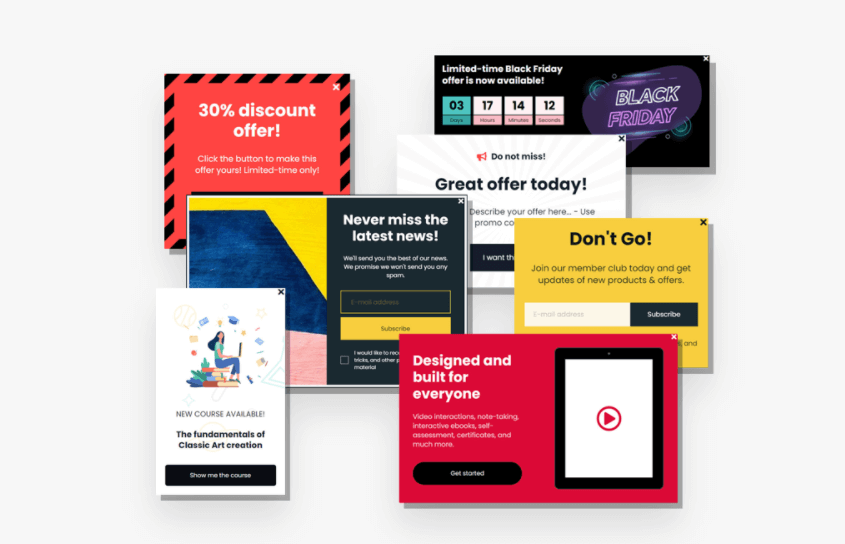
Sidebar: a capture form positioned on either side of content.
Floating bar: a capture form on a bar at the very top of the page.
In-line or slide-in: a capture form between content like blog posts or on top of it.
Capture forms are email marketing tools, so make sure they are prominently visible to users. Apart from website optimization, think about mobile optimization and see if your capture form is accessible on smartphones or other mobile devices.
STEP 3: Run Lead Ads
If you have an active and engaged social media audience, make sure to get them on board your email list. Whether it’s Facebook, Instagram, Twitter, LinkedIn, or Pinterest, invite your followers to keep in touch with you through email.
To maximize results, try the following:
Along with these tactics, you can also get people to easily subscribe to your email list with just two clicks. Here’s how:
A user clicks on a Lead Ad, and a form opens up to gather the user’s contact information. CTA buttons come with the options of “Sign Up,” “Subscribe,” “Learn More,” “Get Quote,” “Download,” “Apply Now.”
Facebook automatically fills out the fields on the form with information from the user’s profile (name, email address, and phone number), which is a great way to capture more leads. Read more about Facebook Lead Ads here.
Email Marketing Campaigns: Where to Start?
To make email marketing happen, you need to consider all aspects that make up the mix of success, including the tools you will need. You already have an email list. Now what you need is an email provider to send out your promotional emails.
If you want to go one step further, though, the best idea is to invest in a dedicated email marketing platform that can help you track, monitor, and optimize your email campaigns.
Choose an Email Marketing Platform
An email marketing platform makes email marketing effortless. While no platform is the same, some of the features they come with – automation, autoresponder, and email optimization, amongst others – can help you organize your email campaigns and target your audience more effectively.
Below are some of the best platforms for launching email marketing campaigns and automating your marketing tasks:
MailChimp
MailChimp is a popular option for email marketing. It provides a beautiful and easy-to-use interface and is used by small eCommerce shops to big online retailers. It is free for up to 10,000 emails per month or 2,000 subscribers. Paid plans start as low as $10/month.
Active Campaign
ActiveCampaign combines email marketing automation with CRM and sales. It is excellent for smarter email marketing campaigns of smaller sizes, and it allows for campaign automation and workflows. It comes with a template editor for beautiful emails and offers friendly signup forms. Its plans begin at $15/month.
ConvertKit
ConvertKit is an email service that provides marketing automation capabilities. It helps to increase conversions through the creation of emails that are more targeted and personalized, corresponding to the needs of the respondents. It comes with a free plan for up to 1,000 subscribers, while paid plans start at $29/month.
Aweber
Aweber has everything you need to grow your email list and engage your audience. Choose from its ready-made templates, create customized emails for your customers, build landing pages, segment your lists, automate your emails, or use its auto-newsletters. It’s free for up to 500 subscribers, and its paid plan starts from
$16.15/month.
Zapier
Zapier features a full integration with LearnWorlds that helps you streamline your tasks and routine workflows and improve the student experience. You can enhance your school management’s efficiency all-round, avoid human errors in your accounting books, and reach out to more leads without lifting a finger. It has a free-forever plan, and its paid plan starts from 17.07/month billed annually.
Autopilot
Autopilot allows you to customize your customer’s journey through a visual interface. It also has a straightforward drag-and-drop editing function for its templates. As a premium smart tool, it has a free plan and starts with $29/month for 2,000 email addresses
GetResponse
GetResponse is a more advanced solution to email flow automation and personalization. It is extremely easy to use and simplifies email marketing for small businesses and absolute beginners. You can get the basic plan for $10.50/month.
*Pricing information retrieved on 16th of June 2021.
There are tons of email marketing platforms available out there, but you will need to choose the one that meets your needs and your business budget the best.
The good news is that all LearnWorlds course creators can enjoy the enhanced capabilities provided by the email marketing automation, as our platform already integrates with some of the most powerful marketing tools available on the market, such as Mailchimp, Active Campaign, ConvertKit, Aweber, and Zapier. Check out our integrations page for more information.
Create the Content
Content is essential to getting your emails opened and read.
Along the way, people may quickly get frustrated or uninterested in your newsletters. So, what’s important here is to take some time to think about: a) who you are sending emails to, b) when you are sending them, and c) how often.
Doing so should help you set some key objectives and then create email content that achieves them. At the same time, don’t be afraid to send out different types of content to retain excitement.
Different types of content to include in your emails:
Keep in mind that to receive value, you have to create value first. Give your subscribers something they care about and make it relevant to your product offering.
Email Marketing Metrics: How to Evaluate and Use Them Effectively
When it comes to email list building and nurturing their audience, email marketers’ biggest fear is the high unsubscribe rates, and you don’t want that to happen to you.
Email metrics can give you the unique opportunity to base your actions on actual data, keep track of your goals, and optimize your email campaigns to boost performance.
Now let’s briefly examine the metrics that you should monitor.
Open rate
Open rate is the number of emails opened compared to the total amount of emails delivered. The open rate reveals how engaged and interested people are in your brand. The subject line and the preheader are elements that affect opening rates the most. You can get the most value out of the open rate as a metric if you use it as a comparative metric in A/B tests.
How to calculate it: (Total open clicks ÷ Number of delivered emails) * 100
Click-through rate
The Click-through rate results from dividing the number of clicks on the links contained (ex., on CTAs) in an email message by the number of emails delivered. It provides a detailed understanding of how many subscribers engage with the content and the type of content they are interested in consuming.
How to calculate it: (Total clicks OR unique clicks ÷ Number of delivered emails) * 100
Click-to-Open rate
Τhe Click-to-Open rate compares the number of click-throughs in the opened emails. While the click-through rate considers all of the inbox actions, the click-to-open rate only includes the actions of those who have opened the email. It is the most accurate metric for measuring the level of interaction that messages can trigger.
How to calculate it: (Total clicks or unique clicks ÷ Number of opened emails) * 100
Bounce Rate
Bounce rates are further classified into hard bounces and soft bounces. Hard bounces are those emails that fail to deliver for permanent reasons, such as the recipient’s address being invalid (e.g., the domain name is incorrect, isn’t real, or the recipient is unknown). Soft bounces refer to temporarily rejected emails because the recipient’s inbox is full, the server isn’t working, or the email exceeds the size limit set by the recipient or the email service provider.
How to calculate it: (Number of non-delivered emails ÷ Number of sent emails) * 100
Spam Score
In some cases, your email might end in the spam folder. It is advisable to avoid creating spam emails because a repetition of those may put you on a blacklist. To avoid them, check the spam score of your messages regularly, use SPF checker to eliminate email security errors and get an anti-spam software that analyzes your email before sending it..
How to calculate it: (Number of spam emails ÷ Number of sent emails) * 100
Conversion rate
Like the click-through rate, the conversion rate is the metric that measures how compelling your message is. It measures the number of clicks in the CTAs inside your emails.
How to calculate it: (Total clicks or unique clicks ÷ Number of delivered emails) * 100
Engagement
Engagement comes with two variables: a) engagement based on time and day, and b) time people spend engaging with email content. Both engagement types are important because they let you know when subscribers are more and less likely to engage with your emails and for how long.
Subscriber list activity
Email service providers give you the ability to track both the growth and decline of your subscriber lists. Knowing how many users unsubscribe, is essential as well as knowing if and how your list is growing. A healthy unsubscribe rate should stay less than 2%. If you see many people unsubscribing, re-evaluate your sending frequency or your messages’ content.
Unengaged subscribers
Unengaged subscribers are old email list contacts that don’t open, click or engage with your email at all. These may hurt your email score algorithm and your reputation, so it is important to keep an eye on them, remove them from your list altogether, put them in a different email segment.
Return on investment
In email marketing, return on investment – aka ROI – monitors how much your emails can help you earn compared to the costs incurred to implement them.
Email sharing rate
Email sharing rate is the metric that measures how many of your sent emails are being forwarded or shared with other people. Knowing to which extent your subscribers are sharing your emails lets you see the extent to which subscribers were entertained and engaged by your email content.
How to calculate it: (Total shares ÷ Number of delivered emails) * 100
Device Type and Email Client
A fundamental principle of email campaign design is to test how email displays on mobile devices and different email clients, both from a creative and content perspective.
By monitoring all or most of these metrics, you will get a comprehensive understanding of your email marketing efforts and a rounded perspective on how they are doing.
Increase Your Course Sales/Conversions (With CTAs)
Ideally, you want your audience to convert to a paying customer. As you build and perfect your email marketing strategy, there are some tactics you can follow to make it easier for people to convert.
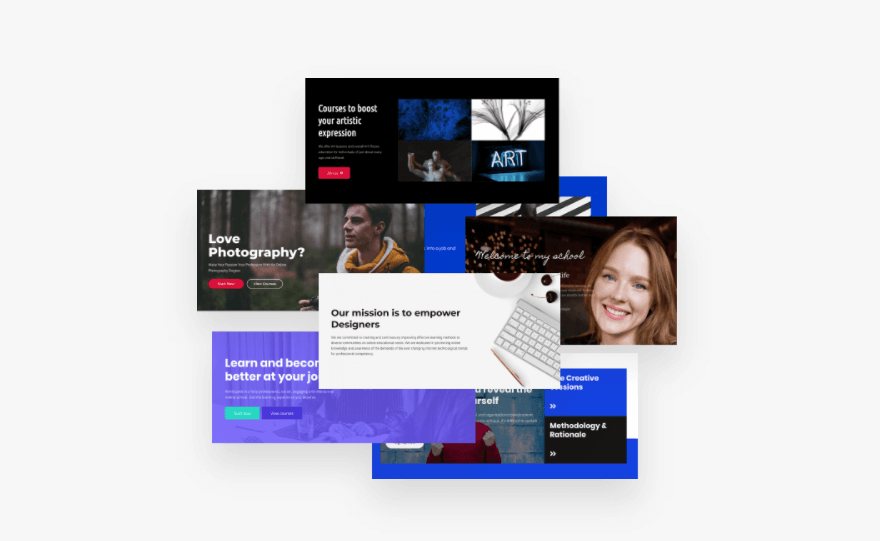
An excellent way to do this is by positioning CTAs at crucial places on your website (like the hero section) and inside your emails. Focusing on a single CTA that prompts users to what you want them to do, like buying your product, is more effective than positioning multiple CTAs through your page or email.
Consider Email Segmentation
Apart from CTAs, though, you can also try out email segmentation.
Meeting customers at the point of their need is essential, and that’s when email segmentation comes in. The big lesson of segmentation is that we can’t treat all of our leads the same. This means that your messaging should respond to your subscribers’ behavior and make each email relevant.
Classifying your email subscribers into segments or groups can increase the likelihood of a recipient opening your emails. That’s because, through personalization, you will target their needs better.
With personalization, you build a subscriber’s loyalty because you increase the value you provide out there. And, loyalty abets conversions.
Some segmentation criteria you can follow:
When it comes to an email campaign, it is not advised to treat everyone the same. Email marketing segmentation helps you to discover untapped potential in your mailing list and take advantage of it.
Best Segmentation Strategies
The simplest way to segment your audience is to divide people into two groups: those who are not yet your customers and those who already are or have bought from you at least once.
This way, you get to send out messages that exclusively apply to each group. For example, you would prompt the first group to buy by sending them offers, engaging them to learn more about your product, offering a free trial, or even inviting them to join a webinar.
Whereas you would send existing customers emails that are less promotional but more loyalty-building based. Since these people already know your product, you should keep sending them company news or approach them to become your affiliates.
Another great segmentation strategy is to divide them into warm leads, hot leads, customers, or unengaged prospects. For each segment, you will send a different set of emails depending on how close they are to buying from you.
Email Writing: How to Write Better Email Content
Coming up with the best email content to use in your email marketing strategy is so important because that is what will keep your audience engaged.
What’s great about emails is that they give you space for personalization, and there are so many ways to create unique content that your subscribers will want to see.
Types of Email Content
There are many different types of emails, and each one has its own purpose. The best way to understand these is to learn how and when to use them.
In every successful email campaign, there are two phases – the educational phase and the selling phase. Both can help your audience prepare for your course launch, and in each step, you will need to send out specific types of emails.
| Educational Phase | Selling Phase |
|---|---|
| Welcome email Newsletter emails Case study emails Survey emails Blog posts/tips emails |
Free gift emails Product offer/discount emails Product launch emails Lead nurturing emails |
The first email you will need to send out is the welcome email immediately after their subscription.
With the welcome email, you get the opportunity to welcome your subscribers officially and thank them for joining. In it, you should explain:
Once the educational phase is over, you need to become more sales-oriented and promotional. You can use the following email sequence to prepare your audience for a course launch:
Email no. 1 – The Course Announcement Email:
Announce that you will open a course on a specific date and what your course will be about. Generate some excitement to your receivers and explain the various modules and of your course. Let them know when it will become available and focus on the benefits of buying it.
Email no. 2 – The Course is Open Email:
Send an email to communicate that your course is open. Include in your email a CTA that will link them to your sales page. Add statistics from valued publications and testimonials and emphasize the value of your course and the effort you have made to create it.
Email no. 3 – The Bonus Email
After the first two launching emails, you have to try to achieve more sales by offering bonus gifts if they buy your course. This bonus gift has to be something very valuable. You are going to provide an additional incentive to get people to buy now.
Email no. 4 – The Retention Email
Some of your recipients may express apathy towards your emails. Most of them don’t have time or simply don’t care enough about your course. Even the best courses have subscribers who forgot why they signed up in the first place. With a retention email, you can show what recipients are missing out on, whether they are totally inactive or just not taking full advantage of your offers.
Email no. 5 – The Thank You Email
Thank everyone for reading your emails and being part of your course launch. Include testimonials where people rave about your course. Build social proof that people have bought and are happy and show your appreciation and gratitude towards them.
Email no. 6 – The Closing Email
One of the bestselling strategies that bring many conversions is claiming that your course will be closing in a day, for example. This way, you are creating a sense of urgency to buy now. Tell them it is their last chance and send them at least three final reminders on that specific day at different times.
After completing the selling phase, you can go back to the educational phase until you have another course launch or offer you want to share with your subscribers.
Email Subject Lines & Openers
Email optimization can do wonders in terms of getting people’s attention.
Since the email subject line is the first thing your subscribers will see in their inbox, they have to be spot-on and super engaging.
These email subject lines speak directly to the people behind the emails, and they also trigger curiosity increasing the likelihood of opening them.
Including your subscriber’s name in the subject line or within the first two sentences of the email is a winning personalization technique you should not ignore. Keeping it short, including emojis and exclamation marks are also excellent strategies. Just make sure to avoid words that trigger spam filters like “Free,” “help,” “percent off,” “reminder.”
💡 Here’s an in-depth guide by the team of experts at Hunter.io on how to create an attention-grabbing subject line.
Email Examples
If you want some inspiration on creating email content and engaging email subject lines, take a look at email examples from companies like Owler, HubSpot, Zapier, LearnWorlds, and more.
See how they are engaging their customers at different stages of their email marketing campaigns.
Owler’s Welcome Email
Email subject line: ‘Welcome to Owler, [Recipient’s Name].’
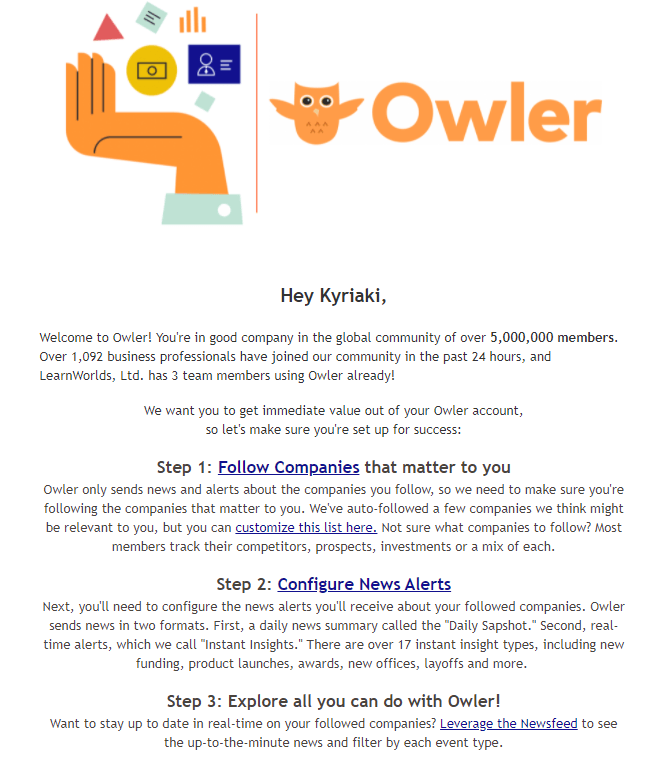
HubSpot’s Expert Tips
Email subject line: ‘Pro tips from inside Google, Facebook and LinkedIn’
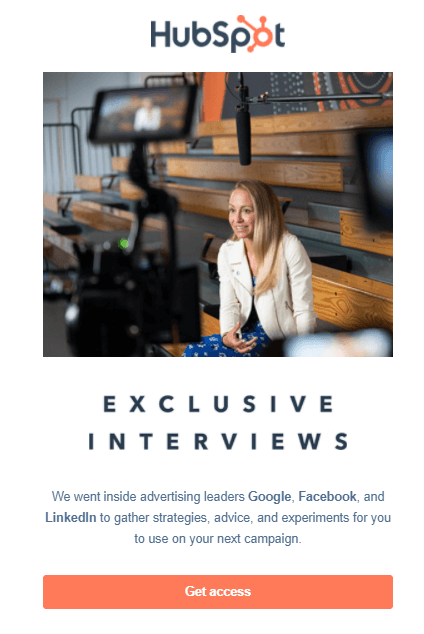
Zapier’s Monthly newsletter
Email subject line: ‘New in June: Get more feedback from your customers’
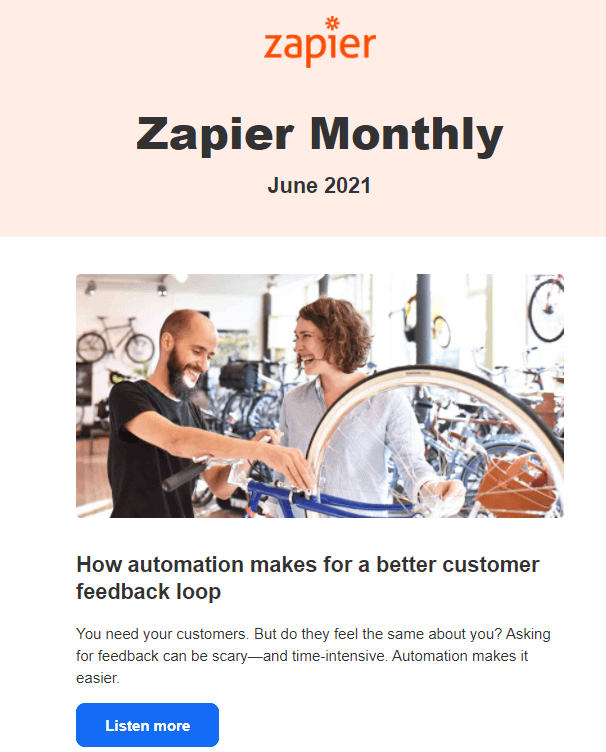
LearnWorlds’ Webinar invitation
Email subject line: ‘Will you be available for this live training?’
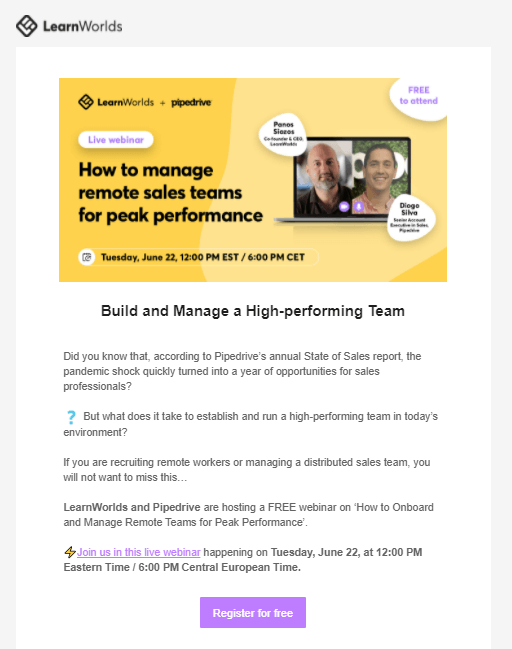
Grammarly’s Premium Offer
Email subject line: ‘Get HALF OFF a FULL YEAR of Grammarly Premium’

Each company has its own way of communicating with its customers, so you will need to experiment with the content to find what works best for you.
Winning Tips for Optimized Content
These are some optimization strategies that work every time:
Ready to Invest in Email Marketing?
Email marketing is the most powerful tool the modern marketer and business owner owns.
As a course creator, you can grow your online business every step of the way through email and learn how to communicate effectively and purposefully with your audience.
As long as you know how to create an attractive landing page that features your course the right way and have your opt-in form and CTA in all the right places, you can get more leads coming your way in no time.
Ready to invest in email marketing? Start creating your email list today!
Kyriaki is a Content Creator for the LearnWorlds team writing about marketing and e-learning, helping course creators on their journey to create, market, and sell their online courses. Equipped with a degree in Career Guidance, she has a strong background in education management and career success. In her free time, she gets crafty and musical.


